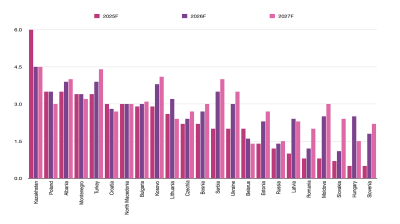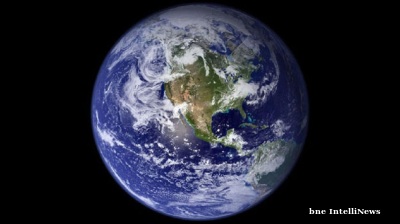The dollar is becoming toxic in regular transactions, Russian Deputy Minister of Foreign Affairs Alexander Pankin told reporters on April 25, 2023. Several countries have drastically reduced their dollar reserves while increasing their gold reserves in 2022.
"These trends show that the US dollar is becoming big, strong, but still toxic for everyday operations. It's not a mainstream trend, but I believe it might become a trend," Pankin added.
As bne IntelliNews reported, many countries are increasingly turning to the yuan as an alternative, but the first thing most have done is turn to the most ancient store of value: gold.
The leading Emerging Markets (EMs) have been freaked out by America’s weaponisation of the dollar as the mainstay of its extreme sanctions regime against Russia. For eight decades the dollar has been a diamond hard currency, but overnight Russia’s $600bn worth of hard currency reserves – the fourth largest in the world – was made useless. In a world where central bankers can no longer trust the dollar they have scrambled to bulletproof their own reserves by accumulating the agnostic yellow metal. This radical change has given real impetus to the long-mooted process of dumping the dollar as the preferred currency for international trade and hard currency reserves.
So far only Russia has taken the radical step of selling off all its currency holdings bar the yuan. But as part of that process Russia intends to increase the share of gold in its monetary reserves to 40% by the end of this year.
And other EMs are following suit. Emerging markets have been the biggest buyers of gold this year as they hunt for alternative and less vulnerable stores of value.
Central banks accumulated gold at the fastest pace on record in the first two months of 2023, according to a report by the World Gold Council’s (WGC) Krishan Gopaul. In January and February, central banks collectively bought a net 125 tonnes of the yellow metal – the largest amount for the year-to-date period since banks became net buyers in 2010 – out of the total 400 tonnes of gold purchased in that period and 1,136 tonnes bought in all of 2022, according to the WGC. And it was EMs that did the most buying. Europe stopped buying large amounts of gold decades ago.
Russian gold
Russia has had a long-standing policy of building up its gold reserves. The CBR has been actively buying gold and increasing its share in reserves since 2007 – the same year that President Vladimir Putin gave his famous speech at the Munich Security conference warning that if Nato didn't stop expanding Russia would push back.
And if anything the pace of CBR purchases has only accelerated in recent years. The CBR set new records for gold purchases ever year for five years in a row between 2012 and 2018 to build up 2,000 tonnes of gold – the same period that President Putin re-tasked the lion’s share of state investment from the economy to modernising the military.
In 2007 Russia’s gold reserves were worth about $14bn out of total reserves of around $420bn. Today Russia has a little less than 2,400 tonnes of gold worth $135bn (22.5%) out of total reserves of $600bn as of April. As the CBR intends to increase the share of gold to 40% of reserves by the end of the year under the new policy, the CBR will continue to be a big buyer of gold all year.
Russia has been increasing gold’s share in its reserves actively since 2007 as part of Putin’s long-term preparation for the possible showdown with the West. Indeed, the CBR has already sold off all its dollar and T-bill holdings and this year says that it will clean out the rest of the currencies it has, leaving only the yuan (60%) and gold (40%) in an unprecedented and highly risky move.
EM gold
In the last year, the other leading EMs have got into the act, buying more gold than at any time since records were started to get out of the dollar and into something that can’t be sanctioned. Reserve managers’ purchases of gold were up 152% last year, the Financial Times reports, according to an annual survey of 83 central bankers who manage $7 trillion in reserves. Respondents said they believed that two thirds of their peers would increase purchases this year.
The countries reporting the largest gold purchases in the first two months of this year include: Singapore (51.4 tonnes), Turkey (45.5 tonnes), China (39.8 tonnes), Russia (31.1 tonnes), Egypt (44.8 tonnes), Iraq (33.9 tonnes) and India (2.8 tonnes), according to WGC.
China now has more than 2,000 tonnes of gold as of December, slightly less than Russia, for the first time ever. Turkey has 542 tonnes after its reserves rose by a quarter in 2022. Countries in the Middle East and Central Asia were also listed by the council as “active buyers” of gold last year by the WGC.
What unites these countries is that they are all having economic problems of various degrees and they are almost all members of the Russian sympathetic bloc and have also seen their relations with the US deteriorate.
Gold is back in vogue, and almost no one has reduced their share of gold in reserves since the war in Ukraine started. Amongst the only net sellers were Kazakhstan and Uzbekistan, but both of those are big gold producers. Croatia and the United Arab Emirates (UAE) also sold, although year-to-date purchases far outweighed sales.
To an extent, the East-West clash has pushed the world back towards using gold as the basic store of value coupled with the increased political will to dump the dollar where possible.
That is a partial abandonment of the 1944 Bretton Woods agreements – and agreement amongst Western countries including the US, Western Europe and Japan – that saw the creation of a fiat currency system based on guaranteed conversion of the dollar and the creation of the International Monetary Fund (IMF) to oversee the system. Set up in the late stages of WWII, the Bretton Woods system guaranteed the dollar’s dominance, but it is also seen as yet another Western system that the leading EMs are increasingly distrustful of.
Going back to gold as a reserve currency not only undermines the dollar; it also undermines the IMF – another institution seen by EMs as dominated by the West. In parallel to buying more gold the EMs have rallied behind the New Development Bank, also known as the BRICS bank, that has been explicitly established as an analogue of the IMF, but is owned by the leading EMs.
Features

Asian economies weigh their options amid fears of over-reliance on Chinese rare-earths
Just how control over these critical minerals plays out will be a long fought battle lasting decades, and one that will increasingly define Asia’s industrial future.

BEYOND THE BOSPORUS: Espionage claims thrown at Imamoglu mean relief at dismissal of CHP court case is short-lived
Wife of Erdogan opponent mocks regime, saying it is also alleged that her husband “set Rome on fire”. Demands investigation.

Turkmenistan’s TAPI gas pipeline takes off
Turkmenistan's 1,800km TAPI gas pipeline breaks ground after 30 years with first 14km completed into Afghanistan, aiming to deliver 33bcm annually to Pakistan and India by 2027 despite geopolitical hurdles.

Looking back: Prabowo’s first year of populism, growth, and the pursuit of sovereignty
His administration, which began with a promise of pragmatic reform and continuity, has in recent months leaned heavily on populist and interventionist economic policies.




